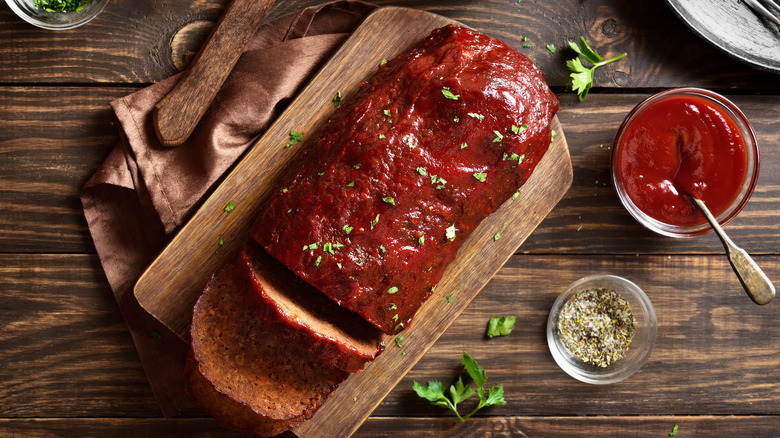Meatloaf's Origins May Go All The Way Back To Ancient Rome
Meatloaf may be a simple dish, but it's a staple for a reason. Whether you're making a classic beef meatloaf or something a little more out of your comfort zone like a turkey quinoa meatloaf, it's the sort of recipe capable of tremendous customization while also still being surprisingly easy to prepare. As such, few dishes feel more American than a meatloaf. Only ...
Meatloaf's origins aren't American at all. Though American meatloaf descends from German settlers making scrapple — a pork loaf with an intense savory taste made of leftover pig scraps — meatloaf goes back much further. By that, we mean Ancient Rome further. The first reference to something that looks a lot like meatloaf comes from "De Re Coquinaria," or "The Art of Cooking," one of the oldest known cookbooks in the world, sometimes known as "Apicius." This meatloaf, however, wasn't made with the type of ground meat we use today. Instead, it appears under the translated moniker "brain sausage" because ... well, it was made with brains. It does what it says on the tin.
The original meatloaf recipe was a little different
Many modern diners might recoil at the thought of eating brains, but it was extremely common for millennia, and many of the recipes in "Apicius" reflect this. The word "meatloaf" does not appear in the recipe, but the process certainly looks like meatloaf. Ground-up cooked brains (the recipe doesn't specify what type of brains) are combined with herbs, spices, broth, and eggs, then thoroughly mixed and molded. The mixture is then cooked, unmolded, and cut into manageable portions (kind of like how we eat it in slices today). Those portions are topped with a sauce — obviously not like modern ketchup, but there's a similar principle at play in that meatloaf typically isn't eaten dry.
Interestingly, not only is this recipe not called "meatloaf" in the original version of "Apicius," but it isn't actually named at all. The name "brain sausage" was given to it by a translator named Isicia de Cerebellis. It doesn't feature a casing, though natural casings long predate the founding of Rome, but "sausage" is historically a pretty mutable term.
We can't truly pinpoint an exact century for meatloaf's creation
Funny enough, though, we don't know exactly when in Roman history meatloaf originated; we can only pin it down to a period of a few centuries. We don't actually know when "Apicius" as a cookbook was originally put together either; the best guess is it was compiled during the 4th century CE. But the person it was likely named after — a gourmand named Marcus Gavius Apicius — lived during the 1st century. This is reflected in the fact that many dishes feature silphium, an herb that the Romans are thought to have driven to extinction only decades after Marcus Gavius Apicius died.
We don't know if Marcus Gavius Apicius himself came up with the recipe, if he was working on the backs of older meatloaf progenitors, or if somehow the recipe was added to the collection later and simply attributed to him. But we owe our thanks to whoever was ultimately responsible for its inclusion in "Apicius." Without it, we may be living in a modern world without meatloaf at all.


